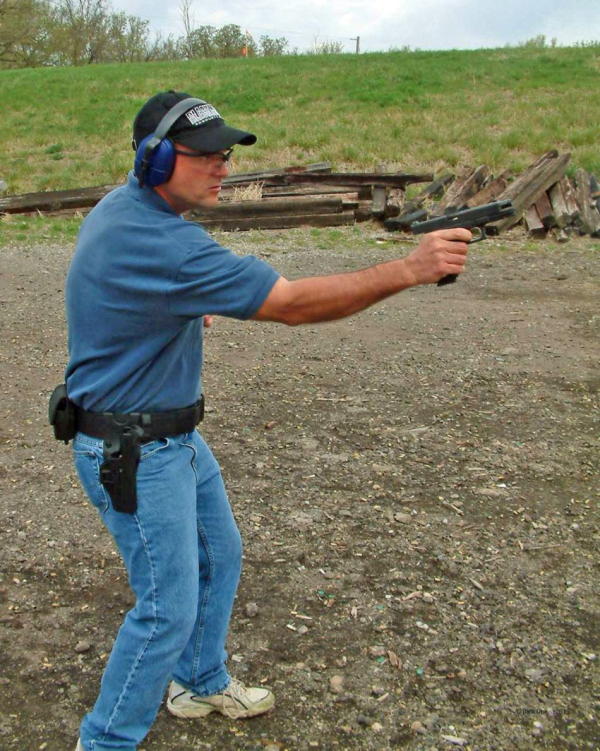“Back in my day,” says the old-timer, “they had different ways.” Yes, they did. I remember my first trip to the range, having just been hired a few weeks earlier. I was put on a line with other shooters facing the old ATS “cartoon” targets. It seems it was fifty rounds, starting up close shooting from the hip (being tougher, we didn’t need that “retention” stuff – or it just hadn’t been thought of), and included shooting from an oddly named “point shoulder” stance. I had no clue what they meant, having had zero training.
I was told to get the gun in front of my face and hold it still as I could while I ran the trigger. As we got further back, we got to shooting in a way more acceptable these days.

Upon reaching the academy, fourteen months after hire, the training included a “point shoulder position without reference to the sights.
“Uh, wait a minute. It’s daylight, we have plenty of time. Why not use the sights?”
Finally, the instructors found a “stupid question.” I don’t recall the answer, perhaps there wasn’t one. What to do …?
I looked at the sights, did fine. They couldn’t tell the difference, except perhaps by scoring the target.
I sallied forth, conflicted by words that made no sense, and that continued through instructor school – not once, but five iterations. While some attempted a relevant discussion about “shooting without sights,” I still found it beyond my stunted education.
Finally, I took a shooting class from Spaulding at an IALEFI Annual conference. He made a comment when he watched me shooting. “You’re taking too long to make that hit. Step it up.”


It was up to me to find out how and that wasn’t wasting a lot of time trying to see what I didn’t need to see.
Hmm. Was this what they meant? Claude Werner made a comment (at least once) about ‘meaningless degrees of precision,’ a term he attributes to a professor under which he once studied. Now, if I’m trying to hit a postage stamp from fifteen feet, it’s going to take some time. If it’s a sheet of printer paper, not so much.
It’s seeing what you need to see to make the hit. People have been trying, with varying degrees of success, to explain that concept for the past 100+ years. In my experience, people who tried to get the concept through to me included friend and mentor Walt Rauch, Jim Cirillo, Mas Ayoob, Lou Chiodo and many others – including competitors like Rob Leatham and Ron Avery.
Walt referred to sights as “training wheels,” instructional aids to learning to point the gun. There’s something to that as semi-auto pistols are somewhat limited in the hand/machine interface when compared to revolvers that can be configured with a range of different stocks.
When I moved to the GLOCK pistol, my results were miserable; I was slow and the hits were less than certain. I trained with that gun, took the aforementioned Spaulding class and others, consuming about three cases of ammo. After that experience, I came to realize that I could look at the 8-ring of the B-8 and shoot, staying within that 8-ring back to around 15 yards or so.


Part of the process is hardwiring the grip – grip is far more critical to keeping the rounds together than sights … or trigger … for most of us. We tend to try to execute the moves “GRIP” and “TRIGGER” at the same time, with predictably disastrous results.
The latest attempt to explain “just shoot the damn gun” comes from ace competitor and Wilson Combat associate Mike Seeklander. I attended a media event where he presented and I learned a lot from him. His recent video for Wilson Combat is titled “Over-Aiming is Wasting Time!” While I value precision over speed, he makes a good point.
More importantly, his description of the process is succinct, makes sense and speaks to me. While I’d been working on “target focus” shooting recently – as you’ll see in upcoming features – I think I’m better prepared to practice after hearing Mike’s explanation.
While I’m at it, this isn’t the “one true way” or “everyone has to do this same type of thing in the same way.” When teaching – and learning – psychomotor skills as in other aspects of adult learning, it’s the communication aspect that’s critical. Just because you sent “Message A” doesn’t mean that everyone got “Message A.” That’s not how humans work.
This is just one more explanation; it just seemed to hit me the right way at the right time in my personal journey. It could well be a waste of your time. Or you’re already doing it.
I was reminded of the process in April when I shot the LEOSA qual. I realized I was watching the target all the way back to ten yards or so. Intense familiarity with the gun was part of the deal.
We’ll continue down the road and will keep you posted.
-- Rich Grassi